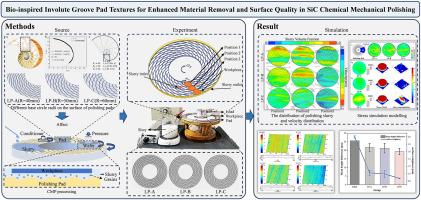仿生渐开线凹槽衬垫纹理增强材料去除和表面质量在SiC化学机械抛光
IF 6.6
2区 材料科学
Q1 MATERIALS SCIENCE, MULTIDISCIPLINARY
Journal of Materials Research and Technology-Jmr&t
Pub Date : 2025-09-19
DOI:10.1016/j.jmrt.2025.09.172
引用次数: 0
摘要
优化抛光垫的织构对于碳化硅等硬质材料的化学机械抛光(CMP)至关重要。本研究从鹦鹉螺腔中汲取灵感,提出了一种新型的仿生渐开线抛光垫设计。基于反应器理论和修正的Preston方程,研究了槽型几何形状对料浆动力学和接触压力的影响。通过流体力学和应力模拟,系统分析了基圆半径分别为40、50和60 mm的三种渐开线凹槽结构。模拟预测60 mm半径织构(LP-C)产生最均匀的浆液流动和理想的高斯类压力分布。随后在SiC衬底上进行的CMP实验验证了这些发现;与其他设计相比,60 mm半径的衬垫提高了材料去除率至少18.87%,表面粗糙度降低了15.10%。这些结果为先进的衬垫纹理提供了一种经过验证的设计策略,表明优化渐开线凹槽几何形状是提高具有挑战性陶瓷材料CMP性能的高效方法。本文章由计算机程序翻译,如有差异,请以英文原文为准。

Bio-inspired involute groove pad textures for enhanced material removal and surface quality in SiC chemical mechanical polishing
Optimizing polishing pad texture is critical for the chemical mechanical polishing (CMP) of hard materials like silicon carbide (SiC). This study introduces a novel bio-inspired involute groove design for polishing pads, drawing inspiration from the nautilus chamber. Based on reactor theory and a modified Preston's equation, the influence of groove geometry on slurry dynamics and contact pressure was investigated. Three involute groove textures with varying base circle radii of 40, 50, and 60 mm were systematically analyzed through fluid dynamics and stress simulations. Simulations predicted that the 60 mm radius texture (LP-C) yields the most uniform slurry flow and a desirable Gaussian-like pressure distribution. Subsequent CMP experiments on SiC substrates validated these findings; the 60 mm radius pad enhanced the material removal rate by at least 18.87 % and reduced surface roughness by 15.10 % compared to the other designs. These results provide a validated design strategy for advanced pad textures, demonstrating that optimizing involute groove geometry is a highly effective approach to improving CMP performance for challenging ceramic materials.
求助全文
通过发布文献求助,成功后即可免费获取论文全文。
去求助
来源期刊

Journal of Materials Research and Technology-Jmr&t
Materials Science-Metals and Alloys
CiteScore
8.80
自引率
9.40%
发文量
1877
审稿时长
35 days
期刊介绍:
The Journal of Materials Research and Technology is a publication of ABM - Brazilian Metallurgical, Materials and Mining Association - and publishes four issues per year also with a free version online (www.jmrt.com.br). The journal provides an international medium for the publication of theoretical and experimental studies related to Metallurgy, Materials and Minerals research and technology. Appropriate submissions to the Journal of Materials Research and Technology should include scientific and/or engineering factors which affect processes and products in the Metallurgy, Materials and Mining areas.
 求助内容:
求助内容: 应助结果提醒方式:
应助结果提醒方式:


